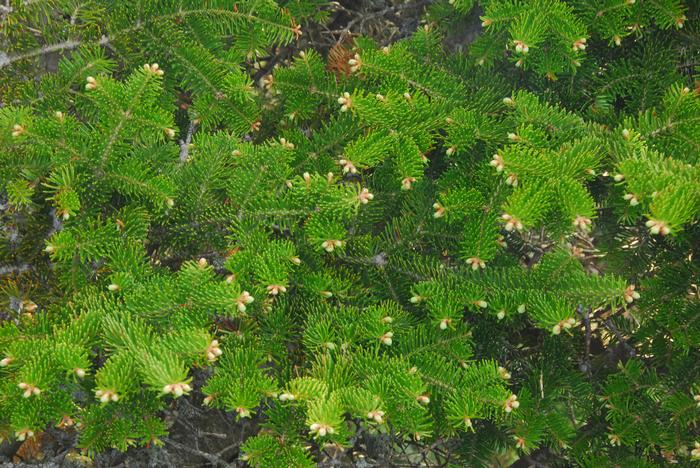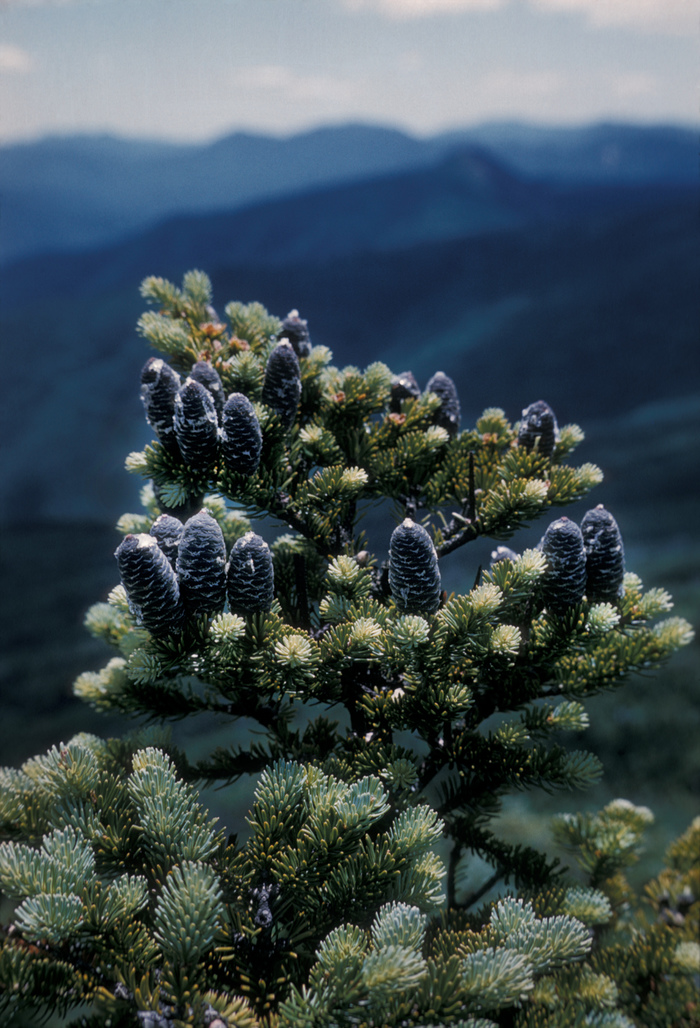General Description
Bloom Description: The inconspicuous male and female parts are found on separate flowers(unisexual), but both exist on the same branch and individual plant (monecious). Young cones are purple. Mature cones sit erect on branches.
Growth Habit & Shape: An evergreen tree with narrow pyramidal or conical form and a spire-like crown.
Soil Preferences: Prefers cool, humusy, slightly acidic, and moist soils. According to the USDA PLANTS fact sheet for this specites: "The soils on which balsam fir grows range from silt loams developed from lake deposits to stony loams derived from glacial till. Fir will grow, but comparatively slowly, on gravelly sands and in peat bogs. It grows on soils of pH ranging from 4.0 to 6.0. "
Root Description: Though seedlings root deeply in the early stages, mature balsam fir are generally shallow-rooted relative to their height, making them susceptible to wind-throw. The lateral roots are usually well-developed, and extend horizontally to 5 or more feet from the base.
Garden Uses: Ornamental specimen tree, windbreaks, and evergreen screening in consistently moist soils.
Best Management & Maintenance: Keep well-watered during drought years.
Common Problems: No serious problems when planted as a landscape plant (rather than in pure or mixed stands in forest settings, or in siviculture settings, where it is susceptible to dieoff because of spruce budworm epidemics).. This tree is intolerant of urban settings.
Benefits
Ornamental Value: Balsam fir is a sumptuous evergreen with distinctive, upright cones and aromatic branches and needles year round.
Wildlife Benefits: Provides cover for birds, snowshoe hare, and other small mammals. Songbirds and squirrels forage on the seeds, and deer and moose browse the foliage. Host plant for 114 species of moth and butterfly larvae including: apple sphinx, fringed looper, imperial moth, Io moth, whitemarked tussock moth and more.
Other Practical/Environmental Benefits: Provides screening, shade, and wind protection.
Use in place of: Picea abies (Norway spruce)
Ecology
Habitat:
Found in cold, moist climates in upland and lowland forests, swamps, and wetland edges thoughout the northeastern US and Canada. This is a dominant tree species in boreal forests.
Response to Disturbance: Balsam fir is considered a sub-climax species in New England and a climax species further North in Canada, where it can be found and pure and mixed stands. The species reacts poorly to soil disturbance and wind, given its shallow root system, and is highly intolerant of drought. This plant does well in minimally-dynamic forest ecosystems, where it may be protected by other, taller tree species or others of its own. Young trees tolerate quite a bit of shade and deer or moose browse, though this may come at the expense of height. Individuals begin to regularly produce seed in their 20th to 30th years, though germination rates tend to be low, and seed viability does not persist for more than one year.
Native State Distributions:
Canada: AB, LB, MB, NB, NF, NS, NU, ON, PE, QC, SK
USA: CT, MA, ME, MI, MN, NH, NJ, NY, OH, PA, RI, VT, WI
Wetland indicator status: FAC
References
- USDA PLANTS database
- Missouri Botanical Garden Plant Finder
- Burns, R., Honkala, B., & [Technical coordinators]. (1990). Silvics of North America: Volume 1. Conifers.
- Uchytil, Ronald J. 1991. Abies balsamea. In: Fire Effects Information System, [Online]. U.S. Department of Agriculture, Forest Service, Rocky Mountain Research Station, Fire Sciences Laboratory (Producer).
- GoBotany
- NatureServe. 2020. NatureServe Explorer: An online encyclopedia of life [web application]. Version 7.2. NatureServe, Arlington, Virginia.
- National Wildlife Federation Native Plant Finder
- Anna Fialkoff, personal communication
Return to Top



